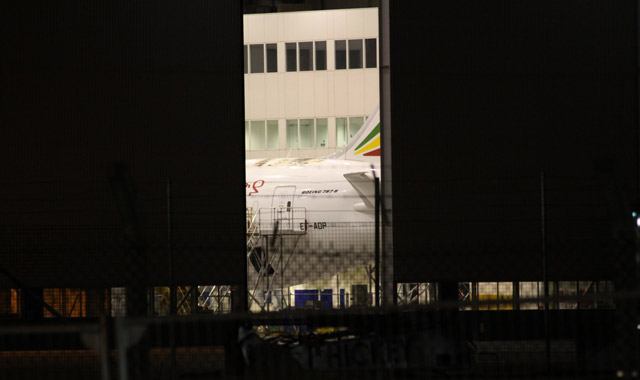Boeing 787 supplier Honeywell confirms it has joined the investigation of the incident aboard the Ethiopian Airlines aircraft parked at London Heathrow on 12 July.
Among other components, Honeywell supplies the 406MHz emergency locater transmitter whose antenna is visible amidst the most serious burn marks atop the crown of the 787 fuselage.
 |
|---|
Ethiopian Boeing 787 inside hangar |
"Honeywell has been participating in the Ethiopian Airlines Boeing 787 fire investigation," Honeywell says.
The supplier emphasises, however, that its participation in the investigation at this point is standard procedure and it still remains too early to "speculate on the cause of the fire".
"Our ELT products have been certified by the [US Federal Aviation Administration] since 2005, are used on a number of aircraft models, and we've not seen nor experienced a single reported issue on this product line," the company adds.
Honeywell also supplies the emergency lighting system, terrain awareness warning system, navigation system and nacelle anti-ice regulators on the 787. But only the ELTs are known to be situated in the area immediately proximate to what Honeywell describes as damage from a "fire".
So far, the UK's Air Accidents Investigation Branch (AATB) has stopped short of describing the incident as a fire and said only that there is no evidence that links the 787's lithium-ion batteries.
Those power sources for the auxiliary power unit and the main back-up were blamed for causing a four-month grounding of the 787 from January until May, following two incidents of overheating batteries on an All Nippon Airways and Japan Airlines aircraft.
The 787 uses less powerful lithium ion batteries in other parts of the aircraft, including the flight control actuators and the emergency lighting system. The ELT system itself is powered by a non-rechargeable lithium manganese-dioxide battery, which is one chemical form of a cathode in a lithium ion battery.
Unlike the more volatile lithium-cobalt-dioxide cathode found in the APU and main batteries on the 787, the ELT battery is not rechargeable and is "similar in make-up to batteries found in digital cameras and watches, albeit larger in size".
There is risk of an explosion and fire in any battery, and the FAA has recorded at least one thermal runaway incident with a lithium manganese battery. On 27 December 2007, a package containing a medical suction pump was being processed by UPS to be shipped by air when it "spontaneously combusted" on a conveyer at a package sort facility in Cerritos, California.
One in-flight incident involving a lithium manganese battery has also been recorded by the US National Transportation Safety Board (NTSB). On 15 December 2006, a passenger wearing a device called a "personal air purifier" on a Continentinal Airlines Boeing 737-800 suddenly heard a loud bang and saw a flash, according to the NTSB report. The device exploded in a volleyball-sized ball of flames that fell between seat cushions and started a fire, which passengers and flight attendants extinguished.
Manganese was detected inside the battery compartment, and the report noted that charging a non-rechargeable battery can cause an "internal short that could lead to thermal runaway, battery failure and possibly an explosion", the NTSB says.
Source: Air Transport Intelligence news



















